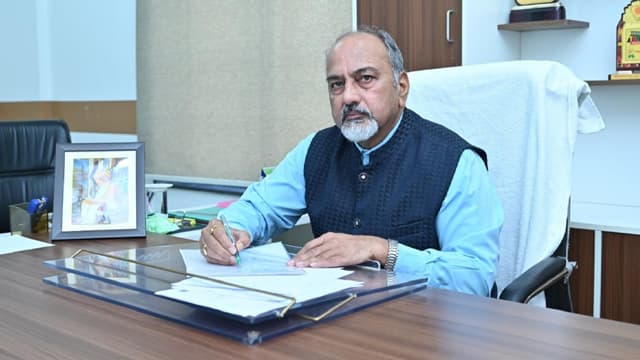Prof. S K Singh, Vice-Chancellor of Shri Rawatpura Sarkar University in Raipur, offers profound insights into the challenges and opportunities within India’s higher education sector, with Education Post’s Prabhav Anand. With expertise in Human Resource Management and Organizational Behavior, Prof. Singh highlights the crucial link between personality variables and organizational performance, emphasizing the need for holistic student development.
Q. Your expertise spans across Human Resource Management and Organizational Behavior, focusing on the intricate link between personality variables and organizational performance. Can you elaborate on the most important findings from your research in this domain and how these insights can inform broader policies within the higher education sector in India?

Generally, people are developed with distinctive characteristics that afterwards determine their personality and the way they behave and respond to their circumstances. The personality variables in the organisational setting are vital to meet corporate goals and increasing overall organizational performance, not only in terms of profit but also in terms of productivity, efficiency, effectiveness and overall employees’ well-being.
A scientific and systematic investigation into the intricate relationship between personality variables and organisational performance revealed that the employees are the most important asset and they contribute most to the overall performance of an organization.
It is therefore imperative for any organization to work consistently and continuously on the development of its human resources. In most institutions of higher education, the focus is more on the development of the left brain of the students, ignoring the development of the right hemisphere of the brain.
The teaching-learning process should be designed in such a way that it not only aims at enriching the domain knowledge but also on the overall personality development of the students. An individual’s contributions are the outcomes of his/her hard skills and soft skills. As such our pedagogy should be directed towards the development of hard skills as well as soft skills of the students with the same solitude.
Q. As a former Vice Chancellor of LN Mithila University and with a distinguished academic career, what do you see as the most pressing challenges facing the higher education sector in India today, and what innovative strategies would you propose to address them effectively?
Lack of adequate infrastructure is an important constraint impacting the quality of teaching-learning in institutions of higher education. We need to make heavy investments in upgrading the physical as well as digital infrastructure of these institutions without which our institutions would stand nowhere in the world ranking.
The poorly designed and obsolete course curriculum leads to a disconnect between what is taught in the university and what is really required in the real world. Our education system has to be aligned with the needs of the industry and society.
Non-availability of quality faculty is also adversely affecting the quality of teaching. There is a need to develop a robust mechanism to train and upgrade the learning skills of the faculty on a continuous basis so that day can remain abreast of the latest teaching gadgets and pedagogies. The institutions located in remote rural areas are the most sufferers because of very poor infrastructure and teacher quality.
They need to be accorded special priority and the government and corporate world should come forward to upgrade them to the level of their urban counterparts.
Q. Critics argue that the traditional pedagogical approaches prevalent in Indian universities hinder critical thinking and creativity among students. How do you propose transforming the curriculum and teaching techniques to promote a culture of innovation and independent thinking in higher education institutions?
Traditional learning methods are often outdated and do not align with the needs of modern-day students. Now it is crucial to adopt innovative learning methods that are engaging interactive and designed to cater to the diverse learning styles of students. The use of technology gamification project-based learning and other innovative teaching methods can help to enhance the learning experience and improve learning outcomes.
In future, universities must prepare their graduates for a world where cyber-physical systems are prevalent across all industries. It means, teaching the students about this technology as part of the curriculum, changing the approach to learning altogether and utilizing this technology to improve the university experiences and better career options.
Q. Your involvement in esteemed academic societies like the National Assessment and Accreditation Council (NAAC) offers unique insights into the quality assurance mechanisms within Indian universities. What systemic changes do you believe are necessary to ensure rigorous and impartial accreditation processes that genuinely reflect the educational standards and outcomes of institutions?
The existing NAAC process does not consider the heterogeneity of the higher education institutions and follows one-size-fits-all model. There is a need to categorize these institutions based on their orientation/vision, heritage/legacy and seek information that is appropriate for their category. There is a special need to focus on rural and remote location institutions through mentoring and hand-holding.
Recently the Radhakrishnan Committee submitted its report recommending transformative changes in the existing NAAC process. It has recommended the metrics for binary and maturity-based graded accreditation focusing on process, outcomes and impact across different attributes of HEIs instead of mere input-centric. Additionally, to enhance the validity and reliability of data, it should also be validated by the stakeholders making the stakeholder an integral part of the accreditation and ranking process.
Q. In recent years, there has been a growing discourse on the commercialization of education in India, leading to concerns about the commodification of knowledge and the prioritization of profit over academic integrity. How do you propose striking a balance between the financial sustainability of universities and their primary mission of knowledge dissemination and societal advancement?
The commodification of education has led to a customer-centric model that pushes universities to compete for students, often based on employability rates rather than the quality of intellectual engagement or knowledge production. The universities have become a place to produce jobready graduates rather than nurturing intellectual growth and critical thinking.
The commodification and commercialisation of education will have profound implications for society and individuals.
It will perpetuate economic inequality by reinforcing the idea that those who can afford to invest in education will reap the most significant economic benefits.
There is a need to strike a balance between the economic model and the holistic model of education which integrates economic consideration with the pursuit of knowledge for its own sake. It requires a revaluation of humanities and social sciences, acknowledging their crucial role in cultivating critical thinking, cultural understanding and civic engagement.
Q. With the rapid advancement of technology and the emergence of online learning platforms, there’s a debate on the future of traditional brick-and-mortar universities. How do you foresee the role of physical campuses evolving in the digital age, and what strategies would you implement to harness the potential of digital technologies while preserving the essence of face-to-face interaction and immersive learning experiences?
Digitalization is going to take a new incarnation in the education system of India. It is undoubtedly an important phase as educational institutions have started to adhere to the new concept of digital learning which is likely to change the overall framework of education. It will ease the way of teaching and learning through responsive resources, userfriendly learning modules, and self-learning methodologies.
However, replacing the classroomlearning model with e-learning completely is not advisable. Certain professional courses have their core values that need practical demonstration and real-time learning. However, the digital platform can be used as a backup or as an add-on facility to be used to improve the learning capability of the students.
Q. India’s higher education landscape is marked by disparities in access and quality, particularly between urban and rural areas and among marginalized communities. How do you propose addressing these inequities to ensure that every student, regardless of their socioeconomic background or geographical location, has equitable opportunities for educational advancement?
The urban-rural divide in education has multi-faceted issues encompassing various factors such as infrastructure, teacher quality, digital literacy and curriculum availability.
The disparities in access and quality cannot be removed unless we ensure that rural institutions are providing students with the same level of learning experiences as their urban counterparts.
To ensure it, the government and the private players must come forward to provide adequate physical as well as digital infrastructure in these rural institutions. The availability of quality education at the doorstep of the rural youths will make it cheaper as they need not migrate to urban locations. The low-cost quality education will reduce the disparities in access and quality of education between rural and urban areas.
Q. As someone deeply engaged in research and academia, what concrete steps would you take to promote a culture of research and innovation within Indian universities, thereby contributing to the country’s knowledge economy and global competitiveness?

NEP-2020 envisages a robust research ecosystem and lays the framework for promoting research and innovation right from the school level. To promote a conducive environment for innovation we will have to address our approach to integrity in research, and existing standards, protocols and policies in the research institutions.
Further, the curricula and methods of teaching and evaluation will have to be flexible to promote a research culture. Ample freedom has to be given to students to ask questions and to explore the problem posed to them kindling their curiosity and perfect understanding of what makes them interested is very essential to build innovative minds. In addition, urgent steps should be taken by the government to spend 6% of GDP on education and earmark a sufficient portion of it for research and innovation.
Researchers across higher education institutions must be encouraged to undertake research studies that are socially relevant and useful to enhance human well-being.

















